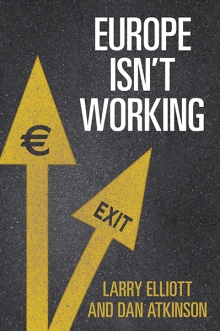
 The sovereign debt crisis in the euro area, which has not been fully addressed and has the potential to re-ignite at any time, has threatened the very survival of the euro and potentially of the European Union (EU). The core thesis put forward in this book is encapsulated by its revealing title Europe Isn’t Working, and the authors set out to explain why.
The sovereign debt crisis in the euro area, which has not been fully addressed and has the potential to re-ignite at any time, has threatened the very survival of the euro and potentially of the European Union (EU). The core thesis put forward in this book is encapsulated by its revealing title Europe Isn’t Working, and the authors set out to explain why.
The book begins with a short history of Economic and Monetary Union (EMU) and the creation of the euro. This is followed by country specific chapters that discuss EMU with reference to Germany, France, the United Kingdom (UK), Greece, Italy, Ireland, and Iceland. The penultimate chapter examines the piecemeal and delayed response to the sovereign debt crisis in the euro area.
The starting point of the analysis is the bad economic performance of the euro area in terms of growth rate, unemployment rate, investment rate, and productivity rate. Moreover, the euro has increased divergence rather than convergence in the euro area. Germany is the “big winner:” in 1999 the income per capita in France and Italy compared to Germany were 99 and 91, respectively. In 2015, the income per capita in comparison to Germany was 89 in France, 74 in Italy, and 64 in Spain. More generally, the euro has brought about (according to the authors) declining living standards, fiscal austerity, the retrenchment of the welfare state, and economic insecurity.
The main argument of the book is that there are major institutional shortcomings in EMU, which explain why it is doomed to fail. These problems are quite well known in the literature on EMU, but it is worth rehearsing them briefly.
To begin with, the euro area is not an optimal currency area (OCA) because of the economic diversity of the member states. Consequently, external asymmetric shocks are likely. Moreover, different national developments in prices and productivity can foster internal asymmetric shocks. For the countries that are members of EMU, the exchange rate is no longer available as an instrument of adjustment, which therefore has to take place in other ways, as explained below. The United States are not an OCA, but, unlike the euro area, they have a federal budget that can be used for stabilization and redistribution.
Second, EMU has severely limited the macroeconomic policy autonomy of the participating countries. Monetary policy is set by the European Central Bank (ECB) and fiscal policy is constrained by the Stability and Growth Pact. The one-size-fits-all monetary policy of the ECB is not suitable for all the euro area countries. Thus, the interest rate set by the ECB is likely to be too low for some countries and too high for others. Moreover, after the completion of EMU, there was a convergence downward of market interest rates, which fuelled the building up of real estate bubbles and/or credit bubbles in the periphery of the euro area. Although the book fails to mention this, the lower interest rates also meant that interest payments on the outstanding public debt of the member states became less expensive. This saving was significant for countries, such as Italy, Greece, and Belgium, whose public debt exceeded 100 percent of the national GDP, and which prior to EMU were penalised by high yield on their government bonds.
Third, in EMU the costs of adjustments to external or internal economic shocks have fallen onto economically weak countries and less well-off people within these countries. Once countries give up the instrument of the exchange rate, which could be devalued in order to improve national competitiveness, the only way to do so is by squeezing labor costs. This so-called “internal devaluation” is politically painful. Moreover, as the book notes “it is a mathematical impossibility for all Eurozone countries to improve their relative competitiveness at the same time.” It is also impossible for all of them to run a trade surplus at the same time. Hence, EMU has been conducive to the building up of macroeconomic imbalances. Indeed, pre-crisis, Germany had a major surplus in its balance of payment and periphery countries run persistent current account deficits.
Fourth, in EMU, macroeconomic imbalances were automatically financed only in so far as capital flowed from countries with current account surpluses to countries with current account deficits, mostly through the intermediation of the banking system. In the first decade of EMU, these capital flows did not fund productive investments in the Southern periphery. Rather these flows funded property developments, securities issued by governments and banks, and credit to households. Once fiscal problems emerged in Greece in 2010, these capital flows came to a halt (and, even worst, reversed) and the banking system in EMU became balkanized. Consequently, a de facto balance of payments crisis erupted. Only the real time gross settlement system operated by the ECB and the Eurosystem – TARGET 2 – prevented a wave of bank defaults, mainly to the benefit of banks in France and Germany that were heavily exposed in the euro periphery.
Fifth, the book dispels the “myth” of the sovereign debt crisis as a fiscal crisis for all periphery countries, apart from Greece. In the other periphery countries hit by the crisis, the excessive borrowing was not in the public sector (hence, related to fiscal policy), it was instead in the private sector. Since the sovereign debt crisis was not principally a fiscal crisis, the EU’s response based on austerity policies was not an effective solution. It actually worsened the crisis, with painful recessionary effects. Furthermore, by acting slowly and in a piecemeal fashion, the EU did not manage to prevent a localised crisis in Greece from turning into systemic crisis that threated the very survival of the euro.
One of the main merits of the book is the articulation of economic arguments outlined above in a clear and easily accessible way. However, the book also insightfully explores the political dynamics that underpin (or most often undermine) the single currency.
First, two strands of intellectual legacies conflated in the construction of EMU. On the one hand, the euro was seen as a way to promote a more competitive Europe in the “battle” for “global economic hegemony” vis-a-vis the EU. This set of ideas mainly provided the rationale for EMU. On the other hand, the ordo-liberal approach based on “sound money,” “sound public finance” and central bank independence informed the design of EMU, that is to say the specific shape that the project took. Eventually, the euro became a neo liberal project based on fiscal austerity and wage-restraint. Interestingly, the centre-left initially supported the euro as a catalyser of new “kinder moderate capitalism,” and only slowly more critical views began to emerge. As the authors remark, “left’s phantasies [about the euro] played to their tragic conclusions” in Greece.
Second, whereas France was the main “architect” of EMU, Germany was the hegemon in it. Over the last decade, Germany has been “less constrained by post-war guilt” and has been willing to use the “political leverage” provided by its “economic strength.” For example, the book criticise the prevailing “German view that the crisis was caused by fiscal mismanagement, industrial incompetence and lack of reform, rather than lack of macroeconomic freedom.”
Third, politicians in the member states have been to slow to understand the institutional shortcomings of EMU and take the necessary measures by moving to a full EMU, with a fiscal union and a political union. In the shorter term, the completion of Banking Union through the creation of a common European deposit guarantee scheme would be a necessary step. Instead, the EU has “kicked the can” down the road, rather than addressing the underlying problems.
Despite the many merits of the book, perhaps some issues could have been subject to a more nuanced assessment. Let us start with the argument that the euro area member states would have been better off without the euro. The problem is that there are no counterfactuals, that is to say, we do not know what would have happened to the euro member states in the absence of EMU. This is especially true for the member states in the periphery. To be fair, the book seeks some counterfactuals by considering the economic performances of the EU member states that did not join the euro, first and foremost, the UK, Sweden, and Denmark. However, these countries are economically and politically different from southern Europe (plus Ireland).
Related to the first point, the countries hit by the crisis had (and arguably, have) underlying economic and political problems to address that cannot be ascribed to EMU. The national authorities in these countries are depicted in the book as powerless to prevent the pre-crisis capital inflows, trade imbalances, and real estate bubbles, which were followed by capital outflows and the bursting of the bubbles when the crisis began. However, these countries had options and instruments at their disposal to mitigate some of these problems—prior to Banking Union, banking supervision was entirely at the national level. But in several instances, the national authorities decided not to act, or worsened the problem. For example, the Irish authorities let their banks expand excessively without adequate supervision. The Spanish authorities actively promoted investment in construction (hence, fuelling the real estate bubble) because this temporarily increased their tax revenues. Prior to the crisis, property price increased five-fold in Spain and so did the living standards.
The “artificially” high growth rate in the euro periphery was due to real estate bubbles, hence prices in these countries increased. By contrast, in Germany, in the first years of the euro, there was a real cut in living standards because the pay rise was below the productivity growth, boosting corporate profits. In first decade of the euro, wage salaries rose of about 20 percent in Germany, compared to 140 percent in Greece, as the book reports. There were also reforms of the labour market and the welfare state in order to make Germany more competitive. The German approach was not copied in the euro area—however, it suggests that whereas this country was able to pro-actively “adjust” to EMU, other countries did not.
There are some amusing anecdotes in the book. For example, the chapter on “the Sisyphus effect” reports that the Greek finance minister Varufakis tried to hack into the computer files of his ministry in order to gain access to the tax account numbers of Greek citizens as part of a scheme to inject parallel liquidity into the Greek economy by crediting electronic money (IOUs) into tax accounts. The chapter on the UK and “the bullet dodged” narrates some behind the scenes events and try to imagine what would have happened if the UK had joined the euro. The answer provided by the chapter is that the crisis would have been worst because the Bank of England would not have been able to act as lender of last resort, and the UK authorities would not have had the macroeconomic flexibility to implement the policies they adopted. Furthermore, the exchange rate could not have acted as instrument of adjustment.
As for the “so what” question, the book concludes that there are only two alternatives. The first one is to complete EMU, which the authors deem as politically unfeasible. The second one is to end EMU, which the author admits is economically risky, but which they recommend. Indeed, they seem somewhat surprised by the persistent political unwillingness to break up the euro. But perhaps that is not so surprising: the euro was from its inception a political project.
Reviewed by Lucia Quaglia, University of York
Europe Isn’t Working
by Larry Elliott and Dan Atkinson
Publisher: Yale University Press
Hardcover / 320 pages / 2016
ISBN: 9780300221923
To read more book reviews, please click here.
Published on June 6, 2017.




